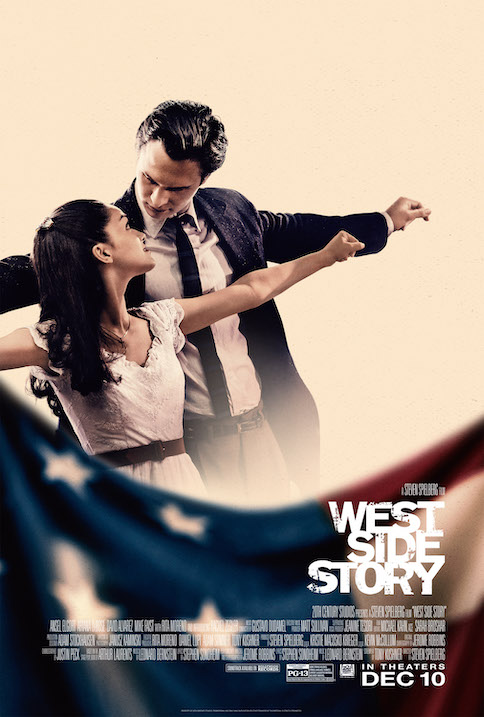‘West Side Story’ Reimagines A Classic (Movie Review)
 West Side Story, the second filmed adaptation of the Tony award-winning Broadway musical, is, shockingly, legendary filmmaker Steven Spielberg’s first full foray into the world of singing and dancing. Besides a USO number in 1941 and that time Kate Capshaw belted a mostly Mandarin “Anything Goes” in the Indiana Jones and the Temple of Doom opener, the Spielberg-verse has been sorely lacking in show-tunes. Finally, two decades into the 21st century, we’re being treated to an outright stunner of a picture featuring songs many know by heart and a story that’s both timeless and timely. Starring Ansel Elgort alongside newcomers Rachel Zelger, Ariana Debose, and Mike Feist. Rita Moreno, who won Best Supporting Actress in the 1961 original, also returns in a different but no less important role. The gang’s all here, so why not feel pretty instead of making with a rumble? Faithful, invigorating, and at the top of the heap when it comes to pure filmmaking, West Side Story is one of the year’s best films.
West Side Story, the second filmed adaptation of the Tony award-winning Broadway musical, is, shockingly, legendary filmmaker Steven Spielberg’s first full foray into the world of singing and dancing. Besides a USO number in 1941 and that time Kate Capshaw belted a mostly Mandarin “Anything Goes” in the Indiana Jones and the Temple of Doom opener, the Spielberg-verse has been sorely lacking in show-tunes. Finally, two decades into the 21st century, we’re being treated to an outright stunner of a picture featuring songs many know by heart and a story that’s both timeless and timely. Starring Ansel Elgort alongside newcomers Rachel Zelger, Ariana Debose, and Mike Feist. Rita Moreno, who won Best Supporting Actress in the 1961 original, also returns in a different but no less important role. The gang’s all here, so why not feel pretty instead of making with a rumble? Faithful, invigorating, and at the top of the heap when it comes to pure filmmaking, West Side Story is one of the year’s best films.

For those unfamiliar with the Robert Wise and Jerome Robbins’ version that won ten Academy Awards (including Best Picture), the story concerns two fractured gangs of immigrants (or at least descendants of) in a slum section of New York City circa the 1950s. The Jets are poor, white, and as Lt. Schrank (Cory Stoll) describes, the last of the “can’t-make-it Caucasians.” The Sharks are Puerto Rican, also poor but at the very least, have a strong sense of community compared to the rage-induced Jets who seemingly grew up with deadbeat dads.
Around their burroughs are numerous demolished buildings, making way for gentrification, which most likely includes new-fangled shopping centers. The remnants of torn-down homes reach up to a sky that has beaten its residents down. Among them are Tony (Elgort) and Maria (Zegler), who fall for each other instantly even though he’s sorta Team Jets and she’s sorta Team Sharks. Amidst the dancing, working for nothing, and rumbling in the streets is a classic Romeo & Juliet tale. Young love caught in the middle of a turf war in a section of the city neither group will have for much longer.
Working with his longtime cinematographer, Janusz Kaminski, Spielberg uses color (or the lack of) to thematically tie this story of have-nots into an evolving color palate. Even though the first act can be muted, almost punishingly so, beauty will eventually blossom. The haunts of the Jets is less merely abandoned and more a war zone – the kind of place a paint can hit an unsuspecting Shark like a bullet.
Eventually, we’ll be treated to some of the most memorable musical numbers in cinema history with lyrics by the late great Steven Sondheim and music by Leonard Bernstein . All of this is accompanied by a camera that swerves in and out of its subjects. Yet, geography is never lost. The dancing is clear and bursting with life. All of this demonstrates how Spielberg is still the master of shot composition and movement. No one has ever been as gifted with such a natural instinct on the best way to shoot a scene.

This isn’t to say this new version is all razzle-dazzle. Although the show originated onstage in 1957, the America of the 21st century is tragically still fraught with the same problems that plagued it back in the mid-20th century. To the credit of the source material, confronting issues of race and even gender was on point even back then. Tony-winner Tony Kushner (Lincoln) does a few tweaks to underline bold scenes on the original script’s pages. A trans character probably rings more relevant in 2021, but, again, the ‘Anybodys’ character already existed back in the 50s. By far, the most harrowing scene in the film, which involves an attempted sexual assault, allows a woman to use the word rape, which wasn’t possible in the 50s. On an emotional and thematic level, it’s just as strong then as it is now.
If there’s a weak link to the cast, I suppose it’s Ansel Elgort, although he delivers a Tony that’s passionate and soulful. He just can’t quite match the singing and dancing of the more classically trained stage performers like David Alvarez or Mike Faist – who are incredible as Bernardo and Riff – but Elgort gets the job done. DeBose, who plays Anita, is especially incredible taking over the role that won Moreno her Oscar. Rachel Zelger (Maria) is an actress on the cusp of breaking out. One of the best aspects of seeing this film is witnessing immense talent on the screen that is nearly all new for me.
West Side Story feels like the kind of movie miracle that I’ll be re-watching a ton as I (fingers crossed) get older, perhaps even as long as veteran Moreno who is 90 years young. I said it before, this is one of the year’s best films.
![]()
![]()
![]()
![]()



















